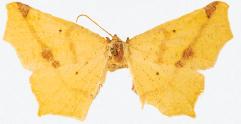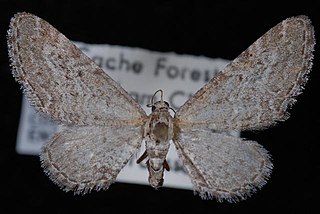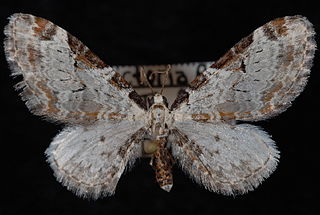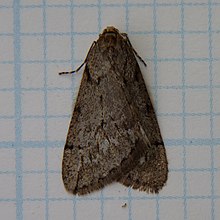
The geometer moths are moths belonging to the family Geometridae of the insect order Lepidoptera, the moths and butterflies. Their scientific name derives from the Ancient Greek geo γῆ or γαῖα "the earth", and metron μέτρον "measure" in reference to the way their larvae, or "inchworms", appear to "measure the earth" as they move along in a looping fashion. A very large family, it has around 23,000 species of moths described, and over 1400 species from six subfamilies indigenous to North America alone. A well-known member is the peppered moth, Biston betularia, which has been subject of numerous studies in population genetics. Several other geometer moths are notorious pests.

Antepione is a genus of moths in the family Geometridae, the geometer moths. The genus was described by Packard in 1876. They occur in North and Central America.

Digrammia was a genus of moths in the family Geometridae erected by Carl Freiherr von Gumppenberg in 1887. It is now often considered a synonym of Semiothisa.
Eriplatymetra is a genus of moths in the family Geometridae erected by Augustus Radcliffe Grote in 1873.

Eufidonia is a genus of moths in the family Geometridae first described by Packard in 1876.
Loxofidonia is a genus of moths in the family Geometridae described by Packard in 1876.
Lytrosis is a genus of moths in the family Geometridae first described by George Duryea Hulst in 1896.

Metarranthis is a genus of moths in the family Geometridae first described by Warren in 1894.
Oncopus is a genus of moths in the family Geometridae first described by Gottlieb August Wilhelm Herrich-Schäffer in 1855. It is a senior homonym of OncopusThorell, 1876, but since this latter genus of opilionids has been much more used in the literature, it has been proposed to the ICZN in 2006 to suppress the Lepidoptera name. The proposal was refused in 2008.

Orthofidonia is a genus of moths in the family Geometridae first described by Packard in 1876.

Pero is a genus of moths in the family Geometridae erected by Gottlieb August Wilhelm Herrich-Schäffer in 1855.

Plagodis is a genus of moths in the family Geometridae erected by Jacob Hübner in 1825.

Paleacrita vernata, the spring cankerworm, is a moth of the family Geometridae. The species was first described by William Dandridge Peck in 1795. It is found in North America from the Atlantic Ocean west to Alberta, Texas and California.
Scopula orientalis is a moth of the family Geometridae. It was described by Sergei Alphéraky in 1876. It is found in Bulgaria, North Macedonia, Ukraine, Russia, Turkey and Korea.

Eupithecia behrensata is a moth in the family Geometridae first described by Alpheus Spring Packard in 1876. It is found in North America from California north to British Columbia, Alberta and Saskatchewan.

Eupithecia ravocostaliata, the tawny eupithecia or great variegated pug, is a moth in the family Geometridae. The species was first described by Alpheus Spring Packard in 1876. It is found in northern New York and the New England states, extending across Canada from the Maritime provinces to Vancouver Island and down the west coast as far as the San Francisco Bay region.

Paleacrita merriccata, the white-spotted cankerworm moth, is a moth of the family Geometridae. The species was first described by Harrison Gray Dyar Jr. in 1903. It is found in eastern North America, where it has been recorded from central Illinois, eastern Missouri, west-central Mississippi, Louisiana and eastern Texas.
Pero meskaria, Meske's pero moth, is a species of moth in the family Geometridae. It was described by Alpheus Spring Packard in 1876 and is found in North America, where it has been recorded from southern Texas west to California, east through Nevada, Utah and western Colorado.
Caberini is a tribe of geometrid moths in the family Geometridae. There are at least 50 described species in Caberini.











